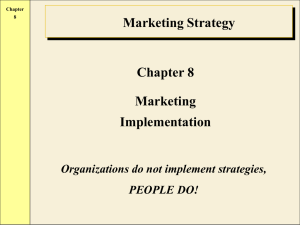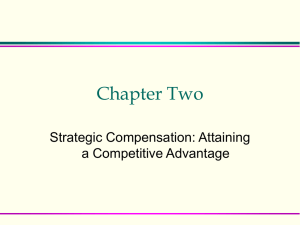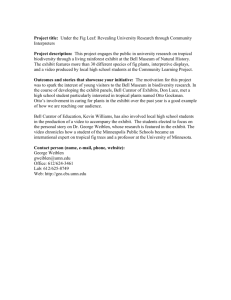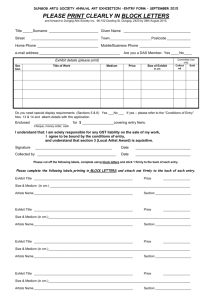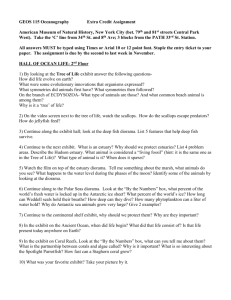lecture_outline_ch10.+
advertisement
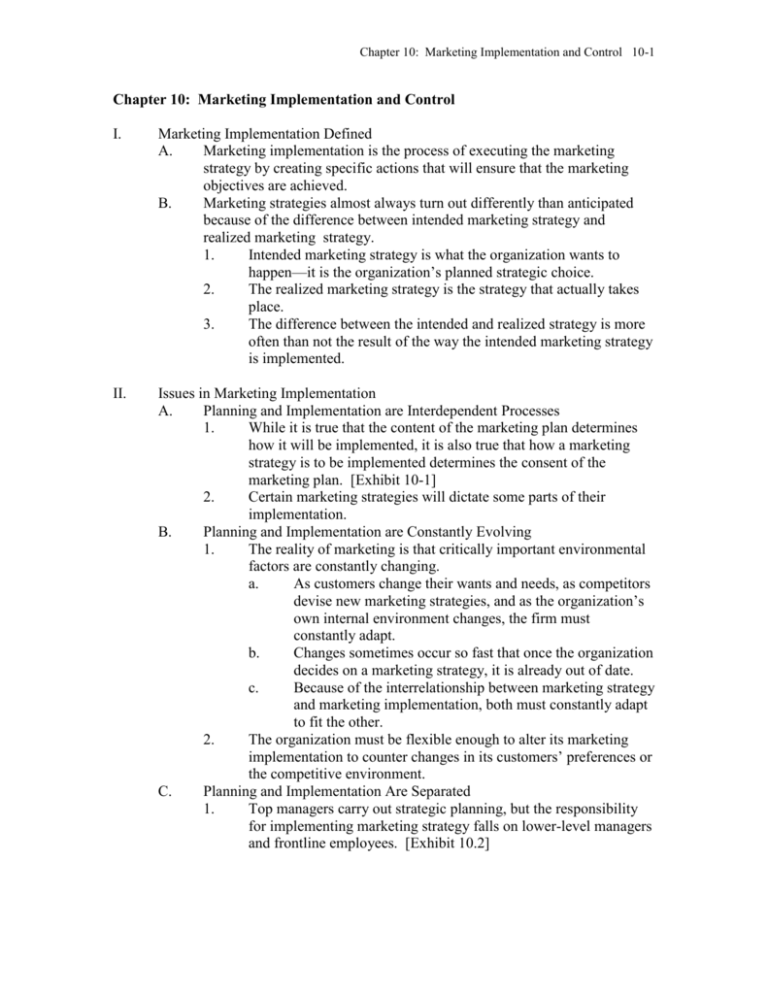
Chapter 10: Marketing Implementation and Control 10-1 Chapter 10: Marketing Implementation and Control I. Marketing Implementation Defined A. Marketing implementation is the process of executing the marketing strategy by creating specific actions that will ensure that the marketing objectives are achieved. B. Marketing strategies almost always turn out differently than anticipated because of the difference between intended marketing strategy and realized marketing strategy. 1. Intended marketing strategy is what the organization wants to happen—it is the organization’s planned strategic choice. 2. The realized marketing strategy is the strategy that actually takes place. 3. The difference between the intended and realized strategy is more often than not the result of the way the intended marketing strategy is implemented. II. Issues in Marketing Implementation A. Planning and Implementation are Interdependent Processes 1. While it is true that the content of the marketing plan determines how it will be implemented, it is also true that how a marketing strategy is to be implemented determines the consent of the marketing plan. [Exhibit 10-1] 2. Certain marketing strategies will dictate some parts of their implementation. B. Planning and Implementation are Constantly Evolving 1. The reality of marketing is that critically important environmental factors are constantly changing. a. As customers change their wants and needs, as competitors devise new marketing strategies, and as the organization’s own internal environment changes, the firm must constantly adapt. b. Changes sometimes occur so fast that once the organization decides on a marketing strategy, it is already out of date. c. Because of the interrelationship between marketing strategy and marketing implementation, both must constantly adapt to fit the other. 2. The organization must be flexible enough to alter its marketing implementation to counter changes in its customers’ preferences or the competitive environment. C. Planning and Implementation Are Separated 1. Top managers carry out strategic planning, but the responsibility for implementing marketing strategy falls on lower-level managers and frontline employees. [Exhibit 10.2] Chapter 10: Marketing Implementation and Control 10-2 2. II. These managers and employees often fail to identify with the organization’s goals and objectives or to understand the marketing strategy because they are separated from the planning process. The Components of Marketing Implementation A. Marketing implementation involves a number of interrelated components and activities that must work together for strategy to be implemented effectively. [Exhibit 10.3] B. Goals and values among all employees within the organization are the “glue” of successful marketing implementation because they bind the entire organization together as a single, functioning unit. 1. The primary means of creating shared goals and values is through employee training and socialization programs. 2. Shared goals and values stimulates organizational commitment where employees become more motivated to implement the marketing strategy and meet customer needs. B. Marketing structure refers to how an organization’s marketing activities are organized. 1. In a centralized marketing structure, all marketing activities and decisions are coordinated and managed from the top of the marketing hierarchy. 2. In a decentralized marketing structure, marketing activities and decisions are coordinated and managed from the front line of the organization. 3. Decentralization means that frontline marketing managers are given the responsibility of making day-to-day marketing decisions. B. Systems and processes are collections of work activities that take in a variety of inputs to create information and communication outputs that ensure the consistent day-to-day operation of the organization. C. An organization’s resources can include a wide variety of assets that can be brought together during marketing implementation. These assets may be tangible or intangible. 1. Tangible resources include financial resources, manufacturing capacity, facilities, and equipment. 2. Intangible resources such as marketing expertise, customer loyalty, brand equity, corporate goodwill, and external relationships/ strategic alliances are equally important. 3. A critical and honest evaluation of available resources during the situation and SWOT analyses can help ensure that the marketing strategy and marketing implementation are within the realm of possibility. D. The quality, diversity, and skill of an organization’s work force are all important considerations in implementing marketing strategy. Human resource issues are becoming more important to the marketing function, especially in the areas of employee selection and training, evaluation and Chapter 10: Marketing Implementation and Control 10-3 E. III. compensation policies, and employee motivation, satisfaction, and commitment. 1. Employee Selection and Training. One of the most critical aspects of marketing implementation is matching employees’ skills and abilities to the marketing tasks to be performed. 2. Employee Evaluation and Compensation Policies. The key is to develop an evaluation and compensation program that ties employee rewards to performance levels on required marketing activities. a) An outcome-based system evaluates and compensates employees based on measurable, quantitative standards, such as sales volume or gross margin levels. b) Behavior-based systems evaluate and compensate employees based on subjective, qualitative standards such as effort, motivation, teamwork, and friendliness toward or problem solving with customers. 3. Other important factors in the implementation of marketing strategy are the extent to which employees are motivated to implement a strategy, their overall feelings of job satisfaction, and the commitment they feel toward the organization and its goals. Leadership provided by an organization’s management and the behaviors of employees go hand in hand in the implementation process. Leadership includes how managers communicate with employees, as well as how they motivate their people to implement a marketing strategy. Approaches to Marketing Implementation A. The command approach is where marketing strategies are evaluated and selected at the top of the organization and forced downward to lower levels where frontline managers and employees are expected to implement them. 1. Advantages are: a) It makes decision making easier, and b) It reduces uncertainty as to what is to be done. 2. Disadvantages are: a) It does not consider the feasibility of implementing the marketing strategy. b) It divides the organization into strategists and implementers, with no consideration for how strategy and implementation affect each other. c) It often creates employee motivation problems because employees are not motivated to implement strategies in which they have little confidence. B. The change approach is similar to the command approach except that it focuses explicitly on implementation. 1. The organization’s structure can be altered; employees can be transferred, hired, or fired; new technology can be adopted; the Chapter 10: Marketing Implementation and Control 10-4 C. D. IV. employee compensation plan can be changed; or the organization can merge with another firm. 2. As opposed to the command approach, the manager taking the change approach toward implementation is more of an architect and politician, skillfully crafting the organization to fit the requirements of the chosen marketing strategy. 3. The change approach is used quite often in business today, sometimes with great success. In the consensus approach, top managers and lower-level managers work together to evaluate and develop marketing strategies. 1. Managers from different areas and levels of the organization come together as a team to “brainstorm” and develop the marketing strategy. 2. It moves some of the decision-making authority closer to the front line where managers are more sensitive to the needs and wants of the organization’s target market customers. 3. For the consensus approach to be truly effective, managers at all levels within the organization must communicate openly about strategy on a daily basis, not just during formal strategy development sessions. The cultural approach carries the participative style of the consensus approach to the lower levels of the organization. Top managers using this approach is to shape the organization’s culture in such a way that all employees—top managers to janitors—participate in making decisions that help the organization reach its objectives. 1. Employees are allowed to design their own work procedures, as long as they are consistent with the organizational mission, goals, and objectives. 2. Employees must be trained and socialized to accept the organization’s mission and to become a part of the organization’s culture. Internal Marketing A. Internal marketing refers to the managerial actions necessary to make all members of the organization understand and accept their respective roles in implementing marketing strategy. B. Under the internal marketing approach, every employee has two sets of customers: external and internal. 1. External customers are the people who shop at the store. 2. Internal customers are the people who work in the store. 3. This same pattern of internal and external customers is repeated throughout all levels of the organization. C. Internal marketing is seen as an output of and input to both marketing implementation and the external marketing program. [Exhibit 10.5] Chapter 10: Marketing Implementation and Control 10-5 1. D. V. Internal products refer to any employee tasks, behaviors, attitudes, and values necessary to ensure implementation of the marketing strategy. 2. The increased effort and changes that employees must exhibit in implementing the strategy are called internal prices. 3. Internal distribution refers to how the marketing strategy is communicated internally. 4. All communication aimed at informing and persuading employees about the merits of the marketing strategy comprise internal promotion. Implementing an Internal Marketing Approach 1. The recruitment, selection, and training of employees must be considered an important component of marketing implementation. 2. Top managers must be completely committed to the marketing strategy and overall marketing plan. 3. Employee compensation programs must be linked to the implementation of the marketing strategy. 4. The organization should be characterized by open communication among all employees, regardless of organizational level. 5. Organizational structures, policies, and processes should match the marketing strategy to ensure that the strategy is capable of being implemented. Evaluating and Controlling Marketing Activities A. A marketing strategy can achieve its desired results only if it is implemented properly. B. A firm’s intended marketing strategy often differs from the realized strategy (the one that actually takes place). C. Typically, there are three possible causes for this difference: 1. The marketing strategy was inappropriate or unrealistic. 2. The implementation was inappropriate for the strategy or was simply mismanaged. 3. The internal and/or external environments changed substantially between the development of the marketing strategy and its implementation. D. To correct any of these problems, marketing activities must be evaluated and controlled on an ongoing basis. E. Formal marketing controls are mechanisms designed by the marketing manager to help ensure the implementation of the marketing strategy. 1. Input control is where the marketing strategy cannot be implemented unless the proper tools are in place for it to succeed. 2. Among the most important input control mechanisms are recruiting, selecting, and training employees. 3. Other examples of input controls include resource allocation decisions (manpower and financial), capital outlays for needed Chapter 10: Marketing Implementation and Control 10-6 F. G. H. VI. facilities and equipment, or increased expenditures on research and development. Process control mechanisms include activities that occur during implementation that are designed to influence the behavior of employees so they will support the strategy and its objectives. [Exhibit 10.6] 1. One of the most important process control mechanisms is the system used to evaluate and compensate employees. 2. Management commitment to the marketing strategy is the single most important determinant of whether the strategy will succeed or fail. Output control mechanisms are designed to ensure that marketing outcomes are in line with anticipated results - setting performance standards against which actual performance can be compared. 1. In setting performance standards, it is important to remember that employees are always responsible for implementing marketing activities, and ultimately the marketing strategy. 2. One of the best methods of evaluating whether performance standards have been achieved is to use a marketing audit to examine systematically the firm’s marketing objectives, strategy, and performance. [Exhibit 10.7] Informal marketing controls are unwritten, employee-based mechanisms that subtly affect the behaviors of employees, both as individuals and in groups. 1. There are three types of informal control: employee self-control, social control, and cultural control. a) Through employee self-control, employees manage their own behavior (and thus the implementation of the marketing strategy) by establishing personal objectives and monitoring their results. b) Social, or small group, control deals with the standards, norms, and ethics that are found within work groups within the organization. c) Cultural is concerned with the behavioral and social norms of the entire organization. Implementing Marketing Activities A. Through good planning and organizing, marketing managers provide purpose, direction, and structure for marketing activities. B. The manager must understand the problems associated with implementation, understand how the various components of implementation are coordinated, and select an overall approach to implementation before actually executing marketing activities. C. The manager must be good at motivating, coordinating, and communicating with all marketing personnel. D. The manager must establish a timetable for the completion of each marketing activity. Chapter 10: Marketing Implementation and Control 10-7 E. Successful implementation also requires that employees know the specific activities for which they are responsible and the timetable for completing each activity. 1. Identifying the specific activities to be performed. 2. Determining the time required to complete each activity. 3. Separating the activities that must be performed in sequence from those that can be performed simultaneously. 4. Organizing the activities in the proper sequence. 5. Assigning the responsibility for completing each activity to one or more employees, teams, or managers. Questions for Discussion 1. Debate question: Which is more important: planning the marketing strategy or implementing the marketing strategy? Forget for a moment that they are equally important. What arguments can you make for one being more important than the other? 2. If you were a marketing manager, which approach to implementation would you be most comfortable using, given your personality and personal preferences? Would your approach be universally applicable to any given situation? If not, how would you adapt your approach? Remember, adapting your basic approach means stepping out of your personal comfort zone to match the situation at hand. 3. What do you see as the major stumbling blocks to the successful use of the internal marketing approach? Given the stratification of employees in most organizations (e.g., CEO, middle management, staff employees), is internal marketing a viable approach for most organizations? Why or why not?



